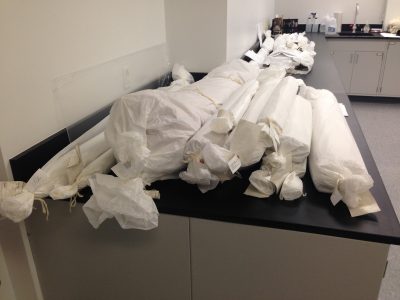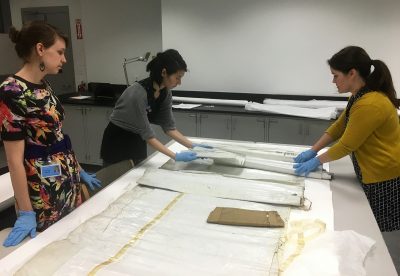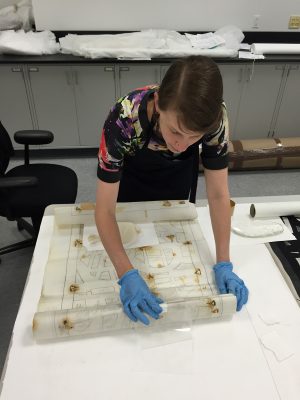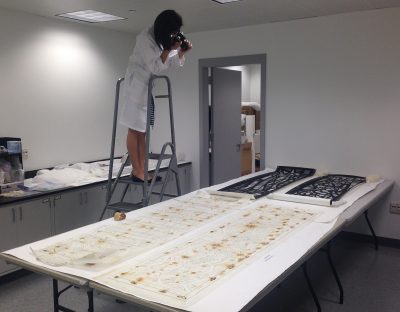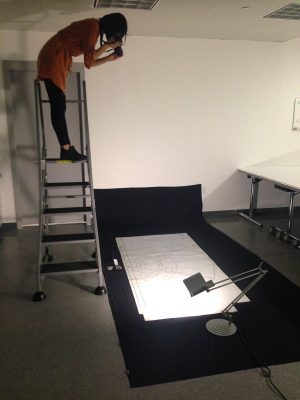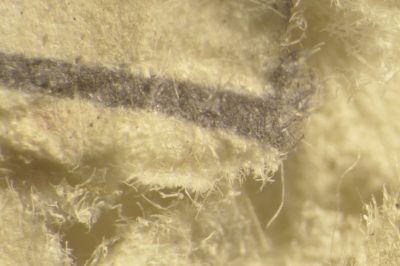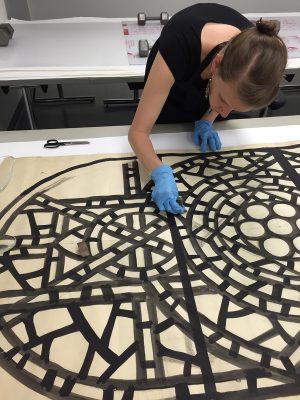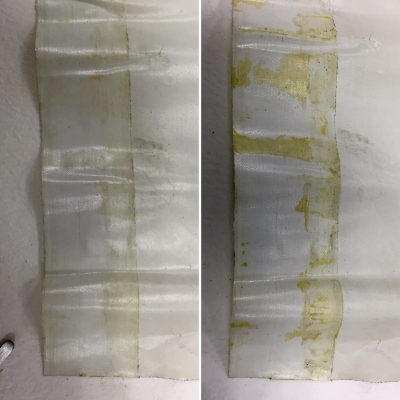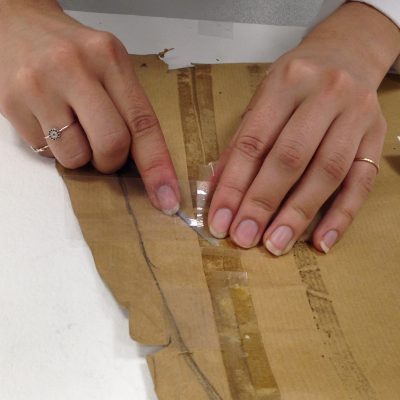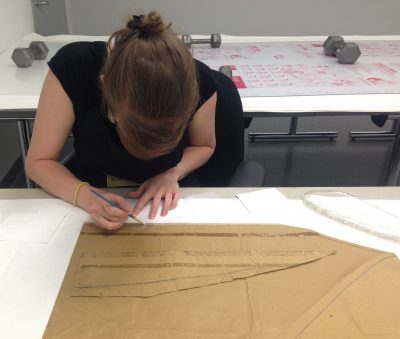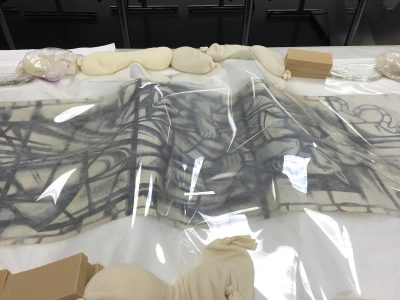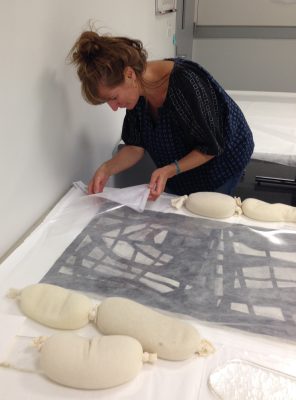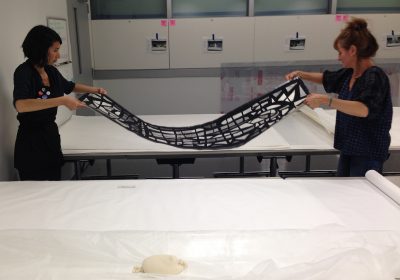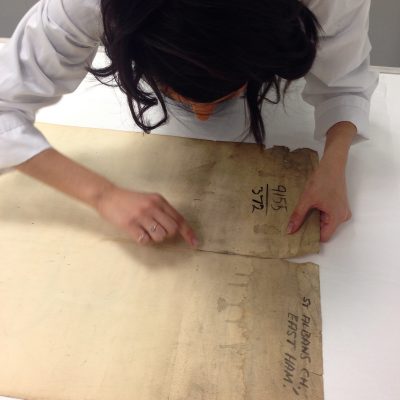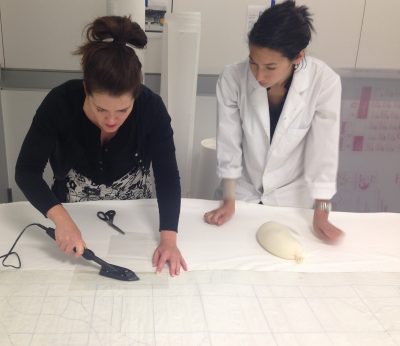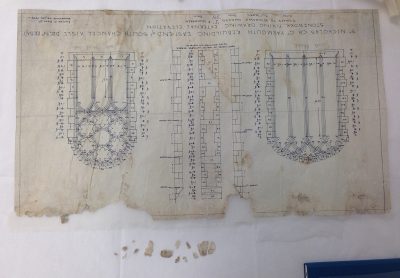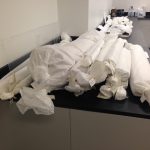
This post comes from Laura Hashimoto and Bonnie Hodul, Rakow Research Library interns who worked on the conservation of the Whitefriars stained glass cartoon collection over the summer of 2016, in conjunction with West Lake Conservators. Read more about this project and the collection in previous posts.
This summer, we treated 62 individual cartoons from 11 different rolls in the Whitefriars collection, which depicted designs for stained glass windows that span the globe. These objects ranged in size, with some no more than 1 foot in length, to the largest spanning the entire Preservation Lab — approximately 19 x 3 feet!
The objects from the Whitefriars collection came to the Preservation Lab in various states, some in much better condition than others. Some cartoons had mud and dirt splattered all over them, or tape that had left a tacky or crusty residue, which needed to be removed; others had tears, losses and cracking along the edges, and folds and creases from being rolled; others simply had a fine layer of surface grime that needed to be carefully cleaned off. The treatment steps required for stabilizing and preparing these objects for high-resolution digitization and re-housing varied slightly for each object, but all objects required some TLC to ensure their continued preservation safely into the future.
Below are some of the steps we took to treat the objects this summer.
Unrolling Objects
- Rolls of objects in the Preservation Lab waiting to be unrolled fully for the very first time!
- Bonnie, Laura, and Moya Dumville from West Lake Conservators carefully unroll objects to assess their condition before proceeding with treatment.
- Sometimes treatment procedures and the order in which we do them varies based on the needs of a particular object. Here, Bonnie locally humidified an area of this tracing paper cartoon that was stuck together, which prevented us from unrolling the object. Once humidified, we could un-stick the area and continue to unroll the object safely.
Treatment Documentation Through Photography
- “Before treatment” photography captures the state the cartoons were in before receiving any treatment. We conduct before treatment photography to document condition issues, as well as to have a point of comparison to the state the object reaches after it has been treated. These objects are canvas cartoons from the roll we treated for Calvary Episcopal Church, New Jersey, USA.
- Laura photographs tracing paper and photograph cartoons, two of which have been treated, and two of which have not yet been treated, to compare the results of the treatment steps taken so far. “During treatment” photography is an important part of treatment documentation for the objects. These objects are from the rolls we treated for St. Peter’s Church, Bristol, England.
- Laura photographs a cartoon after treatment has been completed. “After treatment” photography is necessary both for the documentation of the treatment performed on the object, as well as documentation so that in the future, the state of the object can be assessed over the upcoming years with a point of comparison. The object here is a waxed canvas cartoon for St. Vedast’s Church, London, England, BIB#161877.
Condition Reporting

Laura condition reports one of the paper cartoons made for Temple Emanu-El in New York City, BIB#163463. Condition reporting is a written document that details the state of the object and includes what the object is made of and the media that has been applied to it, as well as any major concerns with it, such as tears and creases, over all dirt and surface grime, etc. The condition report also indicates recommended treatment steps based on the assessment of the object.
Photomicrographs
- Photomicrograph of a paper cartoon showing the paper fibers at a torn edge.
- Bonnie looks through the microscope to see more surface detail of one of the materials we treated in the lab this summer. Microscopes and photographs taken through them (photomicrographs) can help us better understand our materials and specific condition issues associated with them.
Surface Cleaning
- Surface cleaning removes dirt and stray media build-up to reveal the drawing beneath, and is important for the continued preservation of an object as well as to gain valuable information about an object that may be hidden. This wove paper cartoon for St. Mary’s Church in Ajmer, India, BIB#163925, had an inscription that had previously been completely obscured by a tick layer of grime, the right in this image has been cleaned, while the left still needs to be cleaned.
- Laura removes wax deposits from a canvas cartoon for St. Vedast’s Church, London, England.
- Bonnie removes dirt that has lightly accumulated overall on a paper cartoon for Temple Emanu-El, New York City, BIB#148145
Tape and Adhesive Removal
- Some objects have tape and residual adhesive residue that either physically or chemically may cause further damage. Here, we manually removed as much of the crusty residue from this object as possible.
- Laura carefully removes tape that is still stuck to the kraft paper object quite stubbornly.
- Bonnie prepares Japanese tissue with a neutral conservation grade adhesive to re-attach the removed kraft paper piece.
Humidification and Flattening
- Humidification allows the objects to relax – this object is in a humidification chamber, supported carefully where it has strong curls from being tightly rolled for so many years.
- Luisa Casella from West Lake Conservators checks a photograph that has been humidifying to see if it is ready to be transferred to the flattening table.
- Laura and Luisa move a humidified and relaxed photograph to a prepared table for flattening and drying.
Tear Mending and Re-attaching Losses
- : Laura aligns a tear working from the back of a paper cartoon. (BIB#148612). These objects can become brittle over time, which causes tears and pieces to break off. To protect the object from further damage and to piece the valuable information the object can provide back together, we repair the tears and re-attach losses.
- Moya demonstrates to Laura how to apply a conservation grade heat-reactive adhesive to a canvas cartoon.
- [Sometimes an object needs no mending at all, but other times it can be quite a challenge to find where all the pieces of the puzzle fit! BIB#163443.
Re-Housing

